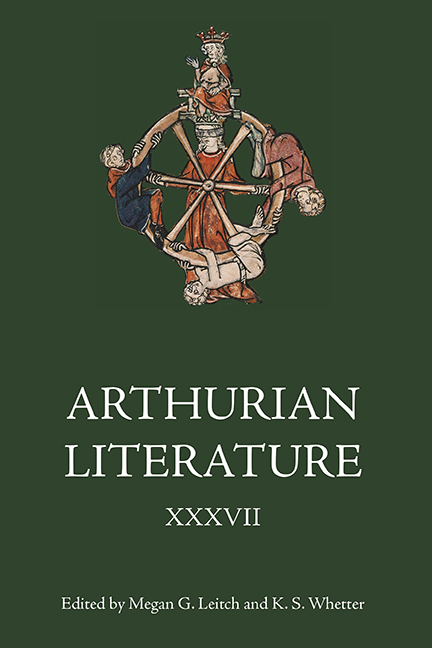Book contents
- Frontmatter
- Contents
- List of Charts and Tables
- Professor Fiona Tolhurst (1968–2021)
- General Editors’ Preface
- List of Contributors
- List of Abbreviations
- Introduction: The Tournament at Mapplemalleoré: Malory at 550
- 1 Malory and the Stock Phrase
- 2 The Artistry of Malory’s Mercantile Metaphors: Goods, Generosity, and the Source of ‘The Tale of Sir Gareth’
- 3 ‘A grete bourder and a passynge good knyght’: Sir Dinadan: ‘Gareth with a Twist’
- 4 Moonlight in the Nocturnal Typology of Malory’s Morte Darthur
- 5 ‘That shall nat ye know for me as at thys tyme’: Cognitive Narratology and Filling Malory’s Gaps
- 6 ‘On a tyme’: Action and Temporality in Malory’s ‘Sankgreal’
- 7 Hospitality in Malory
- 8 The Haunting of the Orkneys and Malory’s Arthurian Project
- 9 ‘I love nat to be constreyned to love’: Launcelot and Coerced Sex
- 10 Eradicating Victorian Backreading: Re-reading Malory’s Gwenyvere through Gaynour and Isode
- contents of previous volumes
8 - The Haunting of the Orkneys and Malory’s Arthurian Project
Published online by Cambridge University Press: 15 September 2022
- Frontmatter
- Contents
- List of Charts and Tables
- Professor Fiona Tolhurst (1968–2021)
- General Editors’ Preface
- List of Contributors
- List of Abbreviations
- Introduction: The Tournament at Mapplemalleoré: Malory at 550
- 1 Malory and the Stock Phrase
- 2 The Artistry of Malory’s Mercantile Metaphors: Goods, Generosity, and the Source of ‘The Tale of Sir Gareth’
- 3 ‘A grete bourder and a passynge good knyght’: Sir Dinadan: ‘Gareth with a Twist’
- 4 Moonlight in the Nocturnal Typology of Malory’s Morte Darthur
- 5 ‘That shall nat ye know for me as at thys tyme’: Cognitive Narratology and Filling Malory’s Gaps
- 6 ‘On a tyme’: Action and Temporality in Malory’s ‘Sankgreal’
- 7 Hospitality in Malory
- 8 The Haunting of the Orkneys and Malory’s Arthurian Project
- 9 ‘I love nat to be constreyned to love’: Launcelot and Coerced Sex
- 10 Eradicating Victorian Backreading: Re-reading Malory’s Gwenyvere through Gaynour and Isode
- contents of previous volumes
Summary
Almost all characters who dance across the pages of Sir Thomas Malory's Morte Darthur die. Sometimes these characters die spectacularly; sometimes they perish off-screen. Some are killed in battle, some felled by (mis)fortune, and some succumb to illness (sometimes love-related and sometimes not). Often the dead disappear the moment they are killed, their role in the text as complete as their lives. But on occasion – and I would argue that it is not an insignificant number of occasions – the dead do not quite exit the story. They appear in the minds and voices of characters and narrator alike. They haunt the Morte, its living characters, and our experience of it. As a prominent example, Gawayne, shortly after dying, appears like a ghost to King Arthur in a dream. This Gawayne offers a reparative path for Arthur: a plan to restore ties with Launcelot and win the ongoing war against Mordred. Ghost-Gawayne, however, is not the only Orkney to haunt Malory's Morte Darthur. Indeed, throughout the text, King Lot and his sons have rather robust afterlives, though they are generally not quite as spectral as Gawayne's ghost. An investigation of the ways in which King Lot functions as a ghost, and of how his sons, in turn, haunt Arthur's court and the text itself, helps us understand the Orkney family's centrality to the story and the problems that centrality produces and reveals.
Before delving into the text and thinking about the Orkneys’ percolating presence in ghostly terms, I want to lay out a few ideas to piece together both the role of the dead in the Middle Ages and how hauntings function in a society. Nancy Mandeville Caciola provides a clear sense of the relationship between the living and the dead in the medieval imaginary. Caciola explains that ‘[t]he dead are poised in a peculiarly vivid symbolic position’. She notes that they are connected to one's past (namely ancestry), but that there is more to it than that. They are also connected to the future, ‘the thickly veiled, imagined realm of postmortem hopes and fears’. She goes on to say that the dead ‘are at the intersection of fundamental ideas about identity and society, fertility and decay, temporal limitations and eternal transcendence.
- Type
- Chapter
- Information
- Arthurian Literature XXXVIIMalory at 550: Old and New, pp. 155 - 174Publisher: Boydell & BrewerPrint publication year: 2022



